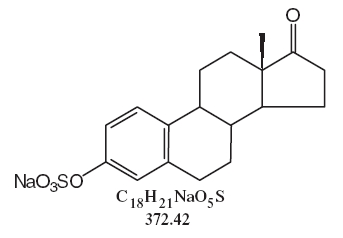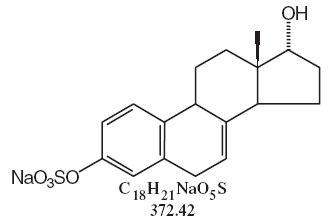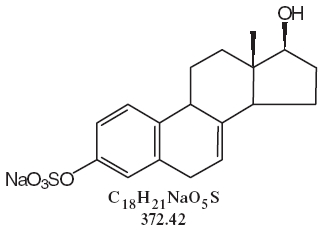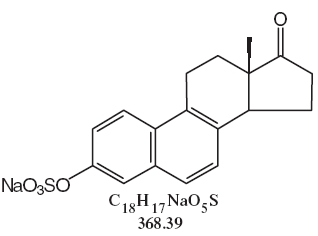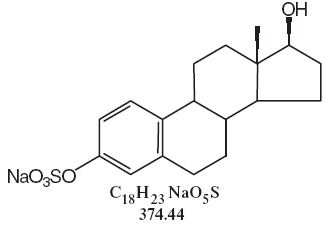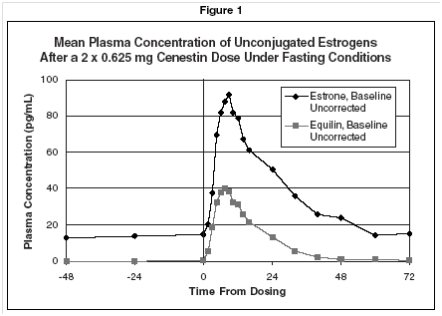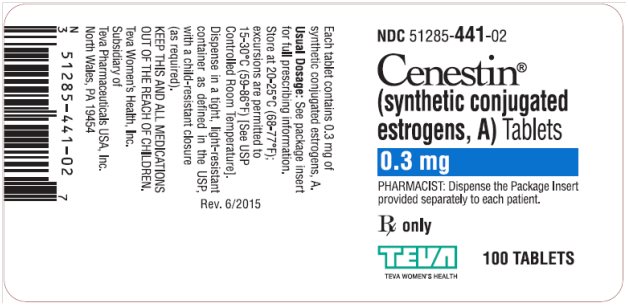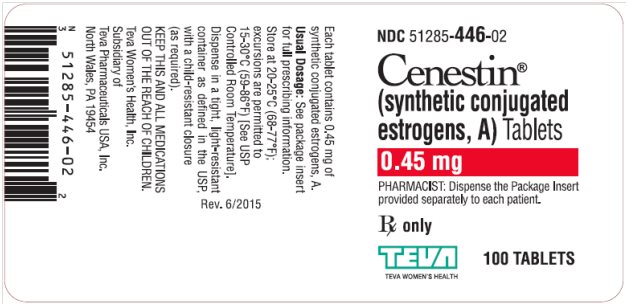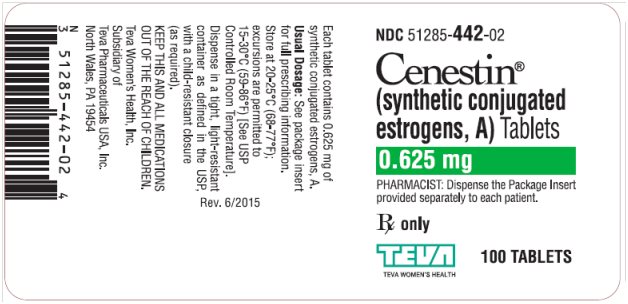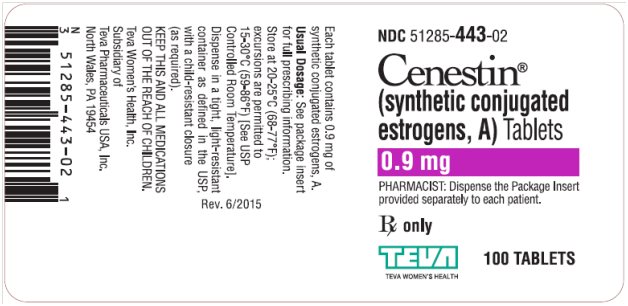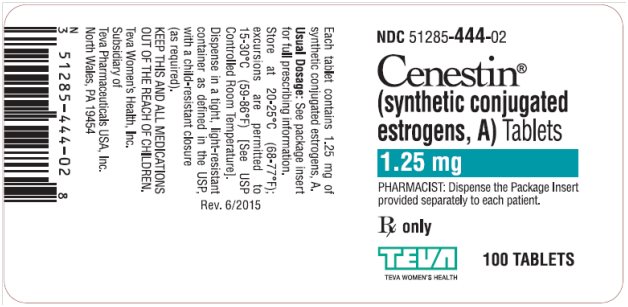CENESTIN- synthetic conjugated estrogens, a tablet, film coated
Teva Women's Health, Inc.
----------
HIGHLIGHTS OF PRESCRIBING INFORMATIONThese highlights do not include all the information needed to use CENESTIN® safely and effectively. See full prescribing information for CENESTIN.
CENESTIN® (synthetic conjugated estrogens, A) Tablets for oral use Initial U.S. Approval: 1999 WARNING: ENDOMETRIAL CANCER, CARDIOVASCULAR DISORDERS, BREAST CANCER AND PROBABLE DEMENTIASee full prescribing information for complete boxed warning.Estrogen-Alone Therapy
Estrogen Plus Progestin Therapy
RECENT MAJOR CHANGESINDICATIONS AND USAGECenestin (synthetic conjugated estrogens, A) tablet is a mixture of estrogens indicated for:
DOSAGE AND ADMINISTRATION
DOSAGE FORMS AND STRENGTHS
CONTRAINDICATIONS
WARNINGS AND PRECAUTIONSADVERSE REACTIONSThe most common adverse reactions (> 10%) are headache, paresthesia, breast pain, abdominal pain, endometrial thickening, metrorrhagia, dizziness, pain, leg cramps, dyspepsia, leukorrhea, vaginitis and nausea (6.1). To report SUSPECTED ADVERSE REACTIONS, contact Teva Pharmaceuticals at 1-888-483-8279 or FDA at 1-800-FDA-1088 or www.fda.gov/medwatch. DRUG INTERACTIONS
USE IN SPECIFIC POPULATIONS
See 17 for PATIENT COUNSELING INFORMATION and FDA-approved patient labeling. Revised: 8/2015 |
FULL PRESCRIBING INFORMATION
WARNING: ENDOMETRIAL CANCER, CARDIOVASCULAR DISODERS, BREAST CANCER AND PROBABLE DEMENTIA
Estrogen-Alone Therapy
Endometrial Cancer
There is an increased risk of endometrial cancer in a woman with a uterus who uses unopposed estrogens. Adding a progestin to estrogen therapy has been shown to reduce the risk of endometrial hyperplasia, which may be a precursor to endometrial cancer. Adequate diagnostic measures, including directed or random endometrial sampling when indicated, should be undertaken to rule out malignancy in postmenopausal women with undiagnosed persistent or recurring abnormal genital bleeding [see Warnings and Precautions (5.2)].
Cardiovascular Disorders and Probable dementia
Estrogen-alone therapy should not be used for the prevention of cardiovascular disease or dementia [see Warnings and Precautions (5.1, 5.3), and Clinical Studies (14.3, 14.4)].
The Women’s Health Initiative (WHI) estrogen-alone substudy reported increased risks of stroke and deep vein thrombosis (DVT) in postmenopausal women (50 to 79 years of age) during 7.1 years of treatment with daily oral conjugated estrogens (CE) [0.625 mg]-alone, relative to placebo [see Warnings and Precautions (5.1), and Clinical Studies (14.3)].
The WHI Memory Study (WHIMS) estrogen-alone ancillary study of the WHI reported an increased risk of developing probable dementia in postmenopausal women 65 years of age or older during 5.2 years of treatment with daily CE (0.625 mg)-alone, relative to placebo. It is unknown whether this finding applies to younger postmenopausal women [see Warnings and Precautions (5.3), Use in Specific Populations (8.5), and Clinical Studies (14.4)].
In the absence of comparable data, these risks should be assumed to be similar for other doses of CE and other dosage forms of estrogens.
Estrogens with or without progestins should be prescribed at the lowest effective doses and for the shortest duration consistent with treatment goals and risks for the individual woman.
Estrogen Plus Progestin Therapy
Cardiovascular Disorders and Probable Dementia
Estrogen plus progestin therapy should not be used for the prevention of cardiovascular disease or dementia [see Warnings and Precautions (5.1, 5.3), and Clinical Studies (14.3, 14.4)].
The WHI estrogen plus progestin substudy reported increased risks of DVT, pulmonary embolism (PE), stroke and myocardial infarction (MI) in postmenopausal women (50 to 79 years of age) during 5.6 years of treatment with daily oral CE (0.625 mg) combined with medroxyprogesterone acetate (MPA) [2.5 mg], relative to placebo [see Warnings and Precautions (5.1), and Clinical Studies (14.3)].
The WHIMS estrogen plus progestin ancillary study of the WHI, reported an increased risk of developing probable dementia in postmenopausal women 65 years of age or older during 4 years of treatment with daily CE (0.625 mg) combined with MPA (2.5 mg), relative to placebo. It is unknown whether this finding applies to younger postmenopausal women [see Warnings and Precautions (5.3), Use in Specific Populations (8.5), and Clinical Studies (14.4)].
Breast Cancer
The WHI estrogen plus progestin substudy also demonstrated an increased risk of invasive breast cancer [see Warnings and Precautions (5.2), and Clinical Studies (14.3)].
In the absence of comparable data, these risks should be assumed to be similar for other doses of CE and MPA, and other combinations and dosage forms of estrogens and progestins.
Estrogens with or without progestins should be prescribed at the lowest effective doses and for the shortest duration consistent with treatment goals and risks for the individual woman.
DOSAGE AND ADMINISTRATION
Generally, when estrogen is prescribed for a postmenopausal woman with a uterus, a progestin should also be considered to reduce the risk of endometrial cancer.
A woman without a uterus does not need progestin. In some cases, however, hysterectomized women with a history of endometriosis may need a progestin [see Warnings and Precautions (5.2, 5.14)].
Use of estrogen-alone, or in combination with a progestin, should be with the lowest effective dose and for the shortest duration consistent with treatment goals and risks for the individual woman. Postmenopausal women should be reevaluated periodically as clinically appropriate to determine if treatment is still necessary.
2.1 Treatment of Moderate to Severe Vasomotor Symptoms due to Menopause
Cenestin therapy consists of a single tablet taken orally once daily.
- •
- Cenestin 0.45 mg
- •
- Cenestin 0.625 mg
- •
- Cenestin 0.9 mg
- •
- Cenestin 1.25 mg
Patients should be started at Cenestin 0.45 mg daily. Subsequent dosage adjustment may be made based upon the individual patient response. This dose should be periodically reassessed by the healthcare provider. The lowest effective dose of Cenestin for the treatment of moderate to severe vasomotor symptoms has not been determined.
2.2 Treatment of Moderate to Severe Symptoms of Vulvar and Vaginal Atrophy due to Menopause
Cenestin therapy consists of a single tablet taken orally once daily.
- •
- Cenestin 0.3 mg
When prescribing solely for the treatment of symptoms of vulvar and vaginal atrophy, topical vaginal products should be considered.
DOSAGE FORMS AND STRENGTHS
Cenestin (synthetic conjugated estrogens, A) Tablets are available as:
0.3 mg round, green, film-coated tablets debossed with the letters, dp, on one side and the number 41 on the other side.
0.45 mg round, orange, film-coated tablets debossed with the letters, dp, on one side and the number 46 on the other side.
0.625 mg round, red, film-coated tablets debossed with the letters, dp, on one side and the number 42 on the other side.
0.9 mg round, white, film-coated tablets debossed with the letters, dp, on one side and the number 43 on the other side.
1.25 mg round, blue, film-coated tablets debossed with the letters, dp, on one side and the number 44 on the other side.
4 CONTRAINDICATIONS
Cenestin is contraindicated in women with any of the following conditions:
- •
- Undiagnosed abnormal genital bleeding
- •
- Known, suspected, or history of breast cancer
- •
- Known or suspected estrogen-dependent neoplasia
- •
- Active DVT, PE, or a history of these conditions
- •
- Active or recent arterial thromboembolic disease (for example, stroke and MI), or a history of these conditions
- •
- Known anaphylactic reaction or angioedema with Cenestin
- •
- Known liver impairment or disease
- •
- Known protein C, protein S, or antithrombin deficiency, or other known thrombophilic disorders
- •
- Known or suspected pregnancy.
5 WARNINGS AND PRECAUTIONS
5.1 Cardiovascular Disorders
An increased risk of stroke and DVT has been reported with estrogen-alone therapy. An increased risk of PE, DVT, stroke and MI has been reported with estrogen plus progestin therapy. Should any of these occur or be suspected, estrogen with or without progestin therapy should be discontinued immediately.
Risk factors for arterial vascular disease (for example, hypertension, diabetes mellitus, tobacco use, hypercholesterolemia, and obesity) and/or venous thromboembolism (VTE) (for example, personal history or family history of VTE, obesity, and systemic lupus erythematosus) should be managed appropriately.
Stroke
In the WHI estrogen-alone substudy, a statistically significant increased risk of stroke was reported in women 50 to 79 years of age receiving CE (0.625 mg)-alone compared to women in the same age group receiving placebo (45 versus 33 per 10,000 women-years). The increase in risk was demonstrated in year 1 and persisted [see Clinical Studies (14.3)]. Should a stroke occur or be suspected, estrogen-alone therapy should be discontinued immediately.
Subgroup analyses of women 50 to 59 years of age suggest no increased risk of stroke for those women receiving CE (0.625 mg)-alone versus those receiving placebo (18 versus 21 per 10,000 women-years).1
In the WHI estrogen plus progestin substudy, a statistically significant increased risk of stroke was reported in women 50 to 79 years of age receiving daily CE (0.625 mg) plus MPA (2.5 mg) compared to women in the same age group receiving placebo (33 versus 25 per 10, 000 women-years) [see Clinical Studies (14.3)]. The increase in risk was demonstrated after the first year and persisted.1 Should a stroke occur or be suspected, estrogen plus progestin therapy should be discontinued immediately.
Coronary Heart Disease
In the WHI estrogen-alone substudy, no overall effect on coronary heart disease (CHD) events (defined as non-fatal MI, silent MI, or CHD death ) was reported in women receiving estrogen-alone compared to placebo2[see Clinical Studies (14.3)].
Subgroup analyses of women 50 to 59 years of age suggest a statistically non-significant reduction in CHD events (CE [0.625 mg]-alone compared to placebo) in women with less than 10 years since menopause (8 versus 16 per 10,000 women-years).
In the WHI estrogen plus progestin substudy, there was a statistically non-significant increased risk of CHD events reported in women receiving daily CE (0.625 mg) plus MPA (2.5 mg) compared to women receiving placebo (41 versus 34 per 10,000 women-years).1 An increase in relative risk was demonstrated in year 1, and a trend toward decreasing relative risk was reported in years 2 through 5 [see Clinical Studies (14.3)].
In postmenopausal women with documented heart disease (n = 2,763, average age 66.7 years of age), in a controlled clinical trial of secondary prevention of cardiovascular disease (Heart and Estrogen/Progestin Replacement Study [HERS]), treatment with daily CE (0.625 mg) plus MPA (2.5 mg) demonstrated no cardiovascular benefit. During an average follow-up of 4.1 years, treatment with CE plus MPA did not reduce the overall rate of CHD events in postmenopausal women with established coronary heart disease. There were more CHD events in the CE plus MPA-treated group than in the placebo group in year 1, but not during the subsequent years. Two thousand, three hundred and twenty-one (2,321) women from the original HERS trial agreed to participate in an open label extension of HERS, HERS II. Average follow-up in HERS II was an additional 2.7 years, for a total of 6.8 years overall. Rates of CHD events were comparable among women in the CE (0.625 mg) plus MPA (2.5 mg) group and the placebo group in HERS, HERS II, and overall.
Venous Thromboembolism
In the WHI estrogen-alone substudy, the risk of VTE (DVT and PE) was increased for women receiving daily CE (0.625 mg)-alone compared to placebo (30 versus 22 per 10,000 women-years), although only the increased risk of DVT reached statistical significance (23 versus 15 per 10,000 women years). The increase in VTE risk was demonstrated during the first 2 years3[see Clinical Studies (14.3)]. Should a VTE occur or be suspected, estrogen-alone therapy should be discontinued immediately.
In the WHI estrogen plus progestin substudy, a statistically significant 2-fold greater rate of VTE was reported in women receiving CE (0.625 mg) plus MPA (2.5 mg) compared to women receiving placebo (35 versus 17 per 10,000 women-years). Statistically significant increases in risk for both DVT (26 versus 13 per 10,000 women-years) and PE (18 versus 8 per 10,000 women-years) were also demonstrated. The increase in VTE risk was demonstrated during the first year and persisted4[see Clinical Studies (14.3)]. Should a VTE occur or be suspected, estrogen plus progestin therapy should be discontinued immediately.
If feasible, estrogens should be discontinued at least 4 to 6 weeks before surgery of the type associated with an increased risk of thromboembolism, or during periods of prolonged immobilization.
5.2 Malignant Neoplasms
Endometrial cancer
An increased risk of endometrial cancer has been reported with the use of unopposed estrogen therapy in a woman with a uterus. The reported endometrial cancer risk among unopposed estrogen users is about 2 to 12 times greater than in non-users, and appears dependent on duration of treatment and on estrogen dose. Most studies show no significant increased risk associated with use of estrogens for less than 1 year. The greatest risk appears associated with prolonged use, with increased risks of 15- to 24-fold for 5 to 10 years or more and this risk has been shown to persist for at least 8 to 15 years after estrogen therapy is discontinued.
Clinical surveillance of all women taking estrogen-alone or estrogen plus progestin therapy is important. Adequate diagnostic measures, including directed or random endometrial sampling when indicated, should be undertaken to rule out malignancy in postmenopausal women with undiagnosed persistent or recurring abnormal genital bleeding. There is no evidence that the use of natural estrogens results in a different endometrial risk profile than synthetic estrogens of equivalent estrogen dose. Adding a progestin to postmenopausal estrogen therapy has been shown to reduce the risk of endometrial hyperplasia, which may be a precursor to endometrial cancer.
Breast cancer
The most important randomized clinical trial providing information about breast cancer in estrogen-alone users is the WHI substudy of daily CE (0.625 mg)-alone. In the WHI estrogen-alone substudy, after an average follow-up of 7.1 years, daily CE-alone was not associated with an increased risk of invasive breast cancer (relative risk [RR] 0.80)5[see Clinical Studies (14. 3)].
The most important randomized clinical trial providing information about breast cancer in estrogen plus progestin users is the WHI substudy of daily CE (0.625 mg) plus MPA (2.5 mg). After a mean follow-up of 5.6 years, the estrogen plus progestin substudy reported an increased risk of invasive breast cancer in women who took daily CE plus MPA. In this substudy, prior use of estrogen-alone or estrogen plus progestin therapy was reported by 26 percent of the women. The relative risk of invasive breast cancer was 1.24, and the absolute risk was 41 versus 33 cases per 10,000 women-years, for CE plus MPA compared with placebo6[see Clinical Studies (14.3)]. Among women who reported prior use of hormone therapy, the relative risk of invasive breast cancer was 1.86, and the absolute risk was 46 versus 25 cases per 10,000 women-years, for CE plus MPA compared with placebo. Among women who reported no prior use of hormone therapy, the relative risk of invasive breast cancer was 1.09, and the absolute risk was 40 versus 36 cases per 10,000 women-years for CE plus MPA compared with placebo. In the same substudy, invasive breast cancers were larger, were more likely to be node positive, and were diagnosed at a more advanced stage in the CE (0.625 mg) plus MPA (2.5 mg) group compared with the placebo group. Metastatic disease was rare, with no apparent difference between the two groups. Other prognostic factors, such as histologic subtype, grade and hormone receptor status did not differ between the groups [see Clinical Studies (14.3)].
Consistent with the WHI clinical trials, observational studies have also reported an increased risk of breast cancer for estrogen plus progestin therapy, and a smaller increased risk for estrogen-alone therapy, after several years of use. The risk increased with duration of use, and appeared to return to baseline over about 5 years after stopping treatment (only the observational studies have substantial data on risk after stopping). Observational studies also suggest that the risk of breast cancer was greater, and became apparent earlier, with estrogen plus progestin therapy as compared to estrogen-alone therapy. However, these studies have not found significant variation in the risk of breast cancer among different estrogen plus progestin combinations, doses, or routes of administration.
The use of estrogen-alone and estrogen plus progestin has been reported to result in an increase in abnormal mammograms requiring further evaluation.
All women should receive yearly breast examinations by a healthcare provider and perform monthly breast self-examinations. In addition, mammography examinations should be scheduled based on patient age, risk factors, and prior mammogram results.
Ovarian Cancer
The WHI estrogen plus progestin substudy reported a statistically non-significant increased risk of ovarian cancer. After an average follow-up of 5.6 years, the relative risk for ovarian cancer for CE plus MPA versus placebo was 1.58 (95 percent CI, 0.77 - 3.24). The absolute risk for CE plus MPA versus placebo was 4 versus 3 cases per 10,000 women-years.7 In some epidemiologic studies, the use of estrogen plus progestin and estrogen-only products, in particular for 5 or more years, has been associated with an increased risk of ovarian cancer. However, the duration of exposure associated with increased risk is not consistent across all epidemiologic studies, and some report no association.
5.3 Probable Dementia
In the WHIMS estrogen-alone ancillary study of WHI, a population of 2,947 hysterectomized women 65 to 79 years of age was randomized to daily CE (0.625 mg)-alone or placebo.
After an average follow-up of 5.2 years, 28 women in the estrogen-alone group and 19 women in the placebo group were diagnosed with probable dementia. The relative risk of probable dementia for CE-alone versus placebo was 1.49 (95 percent CI, 0.83-2.66). The absolute risk of probable dementia for CE-alone versus placebo was 37 versus 25 cases per 10,000 women-years8[see Use in Specific Populations (8.5), and Clinical Studies (14.4)].
In the WHIMS estrogen plus progestin ancillary study, a population of 4,532 postmenopausal women 65 to 79 years of age was randomized to daily CE (0.625 mg) plus MPA (2.5 mg) or placebo.
After an average follow-up of 4 years, 40 women in the CE plus MPA group and 21 women in the placebo group were diagnosed with probable dementia. The relative risk of probable dementia for CE plus MPA versus placebo was 2.05 (95 percent CI, 1.21-3.48). The absolute risk of probable dementia for CE plus MPA versus placebo was 45 versus 22 cases per 10,000 women-years8[see Use in Specific Populations (8.5), and Clinical Studies (14.4)].
When data from the two populations in the WHIMS estrogen-alone and estrogen plus progestin ancillary studies were pooled as planned in the WHIMS protocol, the reported overall relative risk for probable dementia was 1.76 (95 percent CI, 1.19-2.60). Since both ancillary studies were conducted in women 65 to 79 years of age, it is unknown whether these findings apply to younger postmenopausal women8[see Use in Specific Populations (8.5), and Clinical Studies (14.4)].
5.4 Gallbladder Disease
A 2 to 4-fold increase in the risk of gallbladder disease requiring surgery in postmenopausal women receiving estrogens has been reported.
5.5 Hypercalcemia
Estrogen administration may lead to severe hypercalcemia in women with breast cancer and bone metastases. If hypercalcemia occurs, use of the drug should be stopped and appropriate measures taken to reduce the serum calcium level.
5.6 Visual Abnormalities
Retinal vascular thrombosis has been reported in women receiving estrogens. Discontinue medication pending examination if there is sudden partial or complete loss of vision, or a sudden onset of proptosis, diplopia, or migraine. If examination reveals papilledema or renal vascular lesions, estrogens should be permanently discontinued.
5.7 Addition of a Progestin when a Woman has not had a Hysterectomy
Studies of the addition of a progestin for 10 or more days of a cycle of estrogen administration, or daily with estrogen in a continuous regimen, have reported a lowered incidence of endometrial hyperplasia than would be induced by estrogen treatment alone. Endometrial hyperplasia may be a precursor to endometrial cancer.
There are, however, possible risks that may be associated with the use of progestins with estrogens compared to estrogen-alone regimens. These include a possible increased risk of breast cancer.
5.8 Elevated Blood Pressure
In a small number of case reports, substantial increases in blood pressure have been attributed to idiosyncratic reactions to estrogens. In a large, randomized, placebo controlled clinical trial, a generalized effect of estrogens on blood pressure was not seen.
5.9 Hypertriglyceridemia
In women with pre-existing hypertriglyceridemia, estrogen therapy may be associated with elevations of plasma triglycerides leading to pancreatitis. Consider discontinuation of treatment if pancreatitis occurs.
5.10 Hepatic Impairment and/or Past History of Cholestatic Jaundice
Estrogens may be poorly metabolized in women with impaired liver function. For women with a history of cholestatic jaundice associated with past estrogen use or with pregnancy, caution should be exercised, and in the case of recurrence, medication should be discontinued.
5.11 Hypothyroidism
Estrogen administration leads to increased thyroid-binding globulin (TBG) levels. Women with normal thyroid function can compensate for the increased TBG by making more thyroid hormone, thus maintaining free T4 and T3 serum concentrations in the normal range. Women dependent on thyroid hormone replacement therapy who are also receiving estrogens may require increased doses of their thyroid replacement therapy. These women should have their thyroid function monitored in order to maintain their free thyroid hormone levels in an acceptable range.
5.12 Fluid Retention
Estrogens may cause some degree of fluid retention. Women with conditions that might be influenced by this factor, such as a cardiac or renal impairment, warrant careful observation when estrogen-alone is prescribed.
5.13 Hypocalcemia
Estrogen therapy should be used with caution in women with hypoparathyroidism as estrogen-induced hypocalcemia may occur.
5.14 Exacerbation of Endometriosis
A few cases of malignant transformation of residual endometrial implants have been reported in women treated post-hysterectomy with estrogen-alone therapy. For women known to have residual endometriosis post-hysterectomy, the addition of progestin should be considered.
5.15 Hereditary Angioedema
Exogenous estrogens may exacerbate symptoms of angioedema in women with hereditary angioedema.
5.16 Exacerbation of Other Conditions
Estrogen therapy may cause an exacerbation of asthma, diabetes mellitus, epilepsy, migraine, porphyria, systemic lupus erythematosus, and hepatic hemangiomas and should be used with caution in women with these conditions.
5.17 Laboratory Tests
Serum follicle stimulating hormone (FSH) and estradiol levels have not been shown to be useful in the management of moderate to severe vasomotor symptoms and moderate to severe symptoms of vulvar and vaginal atrophy.
5.18 Drug/Laboratory Test Interactions
Accelerated prothrombin time, partial thromboplastin time, and platelet aggregation time; increased platelet count; increased factors II, VII antigen, VIII antigen, VIII coagulant activity, IX, X, XII, VII-X complex, II-VII-X complex, and beta-thromboglobulin; decreased levels of anti-factor Xa and antithrombin III, decreased antithrombin III activity; increased levels of fibrinogen and fibrinogen activity; increased plasminogen antigen and activity.
Increased TBG levels leading to increased circulating total thyroid hormone levels, as measured by protein-bound iodine (PBI), T4 levels (by column or by radioimmunoassay) or T3 levels by radioimmunoassay. T3 resin uptake is decreased, reflecting the elevated TBG. Free T4 and free T3 concentrations are unaltered. Women on thyroid replacement therapy may require higher doses of thyroid hormone.
Other binding proteins may be elevated in serum for example, corticosteroid binding globulin (CBG), sex hormone-binding globulin (SHBG), leading to increased total circulating corticosteroids and sex steroids, respectively. Free hormone concentrations, such as testosterone and estradiol, may be decreased. Other plasma proteins may be increased (angiotensinogen/renin substrate, alpha-1-antitrypsin, ceruloplasmin).
Increased plasma high-density lipoprotein (HDL) and HDL2 cholesterol subfraction concentrations, reduced low-density lipoprotein (LDL) cholesterol concentration, increased triglyceride levels.
Impaired glucose tolerance.
6 ADVERSE REACTIONS
The following serious adverse reactions are discussed elsewhere in the labeling:
- •
- Cardiovascular Disorders [see Boxed Warning, Warning and Precautions (5.1)]
- •
- Malignant Neoplasms [see Boxed Warning, Warning and Precautions (5.2)]
6.1 Clinical Trials Experience
Because clinical trials are conducted under widely varying conditions, adverse reaction rates observed in the clinical trials of a drug cannot be directly compared to rates in the clinical trials of another drug and may not reflect the rates observed in practice.
In a 12-week clinical trial that included 72 women treated with 0.625 mg and 2 x 0.625 mg Cenestin and 48 women treated with placebo, adverse reactions that occurred at a rate of ≥ 5 percent are summarized in Table 1.
- Table 1: Number (%) of Patients with Adverse Reactions with ≥ 5 Percent
- Occurrence Rate By Body System and Treatment Group
|
Body System |
Cenestina
|
|
|
|
Any Adverse Reaction (%) |
68 (94) |
43 (90) |
111 (93) |
|
Body As A Whole | |||
|
Abdominal Pain |
20 (28) |
11 (23) |
31 (26) |
|
Asthenia |
24 (33) |
20 (42) |
44 (37) |
|
Headache |
49 (68) |
32 (67) |
81 (68) |
|
Pain |
8 (11) |
9 (19) |
17 (14) |
|
Digestive System | |||
|
Dyspepsia |
7 (10) |
3 (6) |
10 (8) |
|
Flatulence |
21 (29) |
14 (29) |
35 (29) |
|
Nausea |
13 (18) |
9 (19) |
22 (18) |
|
Vomiting |
5 (7) |
1 (2) |
6 (5) |
|
Metabolic and Nutritional | |||
|
Peripheral Edema |
7 (10) |
6 (13) |
13 (11) |
|
Nervous System | |||
|
Depression |
20 (28) |
18 (38) |
38 (32) |
|
Dizziness |
8 (11) |
5 (10) |
13 (11) |
|
Insomnia |
30 (42) |
23 (48) |
53 (44) |
|
Leg Cramps |
7 (10) |
3 (6) |
10 (8) |
|
Paresthesia |
24 (33) |
15 (31) |
39 (33) |
|
Vertigo |
12 (17) |
12 (25) |
24 (20) |
|
Urogenital System |
21 (29) |
7 (15) |
28 (23) |
|
Breast Pain |
4 (6) |
3 (6) |
7 (6) |
|
Dysmenorrhea |
10 (14) |
3 (6) |
13 (11) |
|
Metrorrhagia |
10 (14) |
3 (6) |
13 (11) |
In a second 12-week clinical trial that included 52 women treated with 0.45 mg Cenestin and 51 women treated with placebo, adverse reactions that occurred at a rate of >5 percent are summarized in Table 2.
- Table 2: Number (%) of Patients with a ≥ 5 Percent Occurrence Rate by Body System
- and Treatment Group
|
Body System and Term |
Cenestin |
Placebo |
|
Any Adverse Reaction (%) |
40 (75.5%) |
39 (76.5%) |
|
Body As A Whole |
20 (37.7%) |
24 (47.1%) |
|
Asthenia |
6 (11.3%) |
7 (13.7%) |
|
Headache |
6 (11.3%) |
8 (15.7%) |
|
Infection |
1 (1.9%) |
6 (11.8%) |
|
Pain |
6 (11.3%) |
1 (2.0%) |
|
Pain abdominal |
5 (9.4%) |
3 (5.9%) |
|
Cardiovascular |
5 (9.4%) |
10 (19.6%) |
|
Palpitations |
3 (5.7%) |
3 (5.9%) |
|
Vasodilations |
2 (3.8%) |
4 (7.8%) |
|
Digestive |
8 (15.1%) |
7 (13.7%) |
|
Nausea |
5 (9.4%) |
2 (3.9%) |
|
Metabolic and Nutritional |
5 (9.4%) |
3 (5.9%) |
|
Weight increase |
3 (5.7%) |
2 (3.9%) |
|
Musculoskeletal |
5 (9.4%) |
6 (11.8%) |
|
Arthralgia |
5 (9.4%) |
5 (9.8%) |
|
Myalgia |
2 (3.8%) |
6 (11.8%) |
|
Neurological |
15 (28.3%) |
19 (37.3%) |
|
Anxiety |
3 (5.7%) |
1 (2.0%) |
|
Insomnia |
3 (5.7%) |
5 (9.8%) |
|
Nervousness |
2 (3.8%) |
7 (13.7%) |
|
Paresthesia |
4 (7.5%) |
3 (5.9%) |
|
Vertigo |
3 (5.7%) |
3 (5.9%) |
|
Respiratory |
10 (18.9%) |
6 (11.8%) |
|
Rhinitis |
3 (5.7%) |
2 (3.9%) |
|
Urogenital |
19 (35.8%) |
7 (13.7%) |
|
Endometrial thickening |
10 (18.9%) |
4 (7.8%) |
|
Vaginitis |
4 (7.5%) |
1 (2.0%) |
If a subject experiences the same event more than once, the first occurrenceis tabulated.
In a 16-week clinical trial that included 36 women treated with 0.3 mg Cenestin and 34 women treated with placebo, adverse reactions that occurred at a rate of >5 percent are summarized in Table 3.
- Table 3: Number (%) of Patients with Adverse Reactions with ≥ 5 Percent
- Occurrence Rate By Body System and Treatment Group
|
Body System and Term |
Cenestin |
Placebo |
|
Body as a Whole |
22 (60) |
13 (38) |
|
Allergic Reaction |
3 (8) |
1 (3) |
|
Flu Syndrome |
3 (8) |
1 (3) |
|
Injury Accident |
2 (5) |
1 (3) |
|
Back Pain |
2 (5) |
1 (3) |
|
Cyst |
2 (5) |
0 (0) |
|
Asthenia |
3 (8) |
2 (6) |
|
Digestive |
10 (27) |
8 (24) |
|
Nausea |
4 (11) |
2 (6) |
|
Dyspepsia |
2 (5) |
1 (3) |
|
Vomiting |
3 (8) |
0 (0) |
|
Increased Appetite |
2 (5) |
0 (0) |
|
Neurological |
7 (19) |
7 (21) |
|
Dizziness |
3 (8) |
0 (0) |
|
Urogenital |
22 (60) |
16 (47) |
|
Leukorrhea |
12 (32) |
5 (15) |
|
Vaginitis |
9 (24) |
5 (15) |
|
Urinary Incontinence |
3 (8) |
1 (3) |
|
Metrorrhagia |
2 (5) |
0 (0) |
|
Urinary Frequency |
2 (5) |
0 (0) |
6.2 Post Marketing Experience
The following adverse reactions have been identified during post-approval use of Cenestin. Because these reactions are reported voluntarily from a population of uncertain size, it is not always possible to reliably estimate their frequency or establish a causal relationship to drug exposure.
Gastrointestinal disorders: abdominal distension, nausea
Investigations: weight increased
Metabolism & Nutrition Disorders: fluid retention
Neoplasms: breast cancer
Nervous System Disorders: headache, insomnia, somnolence
Psychiatric Disorder: depression
Reproductive System and Breast Disorders: breast enlargement, breast pain, breast swelling, breast tenderness
Skin & Subcutaneous Tissue Disorders: alopecia, pruritus, pruritus generalized, rash pruritic, rash
7 DRUG INTERACTIONS
No drug-drug interaction studies have been conducted with Cenestin
7.1 Metabolic Interactions
In vitro and in vivo studies have shown that estrogens are metabolized partially by cytochrome P450 3A4 (CYP3A4). Therefore, inducers and inhibitors of CYP3A4 may affect estrogen drug metabolism. Inducers of CYP3A4 such as St. John’s wort (Hypericum perforatum) preparations, phenobarbital, carbamazepine, and rifampin may reduce plasma concentrations of estrogens, possibly resulting in a decrease in therapeutic effects and/or changes in the uterine bleeding profile. Inhibitors of CYP3A4 such as erythromycin, clarithromycin, ketoconazole, itraconazole, ritonavir and grapefruit juice may increase plasma concentrations of estrogens and may result in side effects.
8 USE IN SPECIFIC POPULATIONS
8.1 Pregnancy
Cenestin should not be used during pregnancy [See Contraindications (4)]. There appears to be little or no increased risk of birth defects in children born to women who have used estrogens and progestins as an oral contraceptive inadvertently during early pregnancy.
8.3 Nursing Mothers
Cenestin should not be used during lactation. Estrogen administration to nursing women has been shown to decrease the quantity and quality of the breast milk. Detectable amounts of estrogens have been identified in the breast milk of women receiving estrogen-alone therapy. Caution should be exercised when Cenestin is administered to a nursing woman.
8.4 Pediatric Use
Cenestin is not indicated in children. Clinical studies have not been conducted in the pediatric population.
8.5 Geriatric Use
There have not been sufficient numbers of geriatric women involved in studies utilizing Cenestin to determine whether those over 65 years of age differ from younger subjects in their response to Cenestin.
The Women’s Health Initiative Studies
In the WHI estrogen-alone substudy (daily CE [0.625 mg]-alone versus placebo), there was a higher relative risk of stroke in women greater than 65 years of age [see Clinical Studies (14.3)].
In the WHI estrogen plus progestin substudy (daily CE [0.625 mg] plus MPA [2.5 mg] versus placebo), there was a higher relative risk of nonfatal stroke and invasive breast cancer in women greater than 65 years of age [see Clinical Studies (14.3)].
The Women’s Health Initiative Memory Study
In the WHIMS ancillary studies of postmenopausal women 65 to 79 years of age, there was an increased risk of developing probable dementia in women receiving estrogen-alone or estrogen plus progestin when compared to placebo. [see Warnings and Precautions (5.3), and Clinical Studies (14.4)].
Since both ancillary studies were conducted in women 65 to 79 years of age, it is unknown whether these findings apply to younger postmenopausal women8[see Warnings and Precautions (5.3), and Clinical Studies (14.4)].
10 OVERDOSAGE
Overdosage of estrogen may cause nausea and vomiting, breast tenderness, abdominal pain, drowsiness and fatigue, and withdrawal bleeding may occur in women. Treatment of overdose consists of discontinuation of Cenestin therapy with institution of appropriate symptomatic care.
11 DESCRIPTION
Cenestin (synthetic conjugated estrogens, A) tablets contain a blend of nine (9) synthetic estrogenic substances. The estrogenic substances are sodium estrone sulfate, sodium equilin sulfate, sodium 17α-dihydroequilin sulfate, sodium 17α-estradiol sulfate, sodium 17β-dihydroequilin sulfate, sodium 17α-dihydroequilenin sulfate, sodium 17β-dihydroequilenin sulfate, sodium equilenin sulfate and sodium 17β-estradiol sulfate.
The structural formulae for these estrogens are:
Sodium Estrone Sulfate
Sodium Equilin Sulfate
Sodium 17α-Dihydroequilin Sulfate
Sodium 17α-Estradiol Sulfate
Sodium 17β-Dihydroequilin Sulfate
Sodium 17α-Dihydroequilenin Sulfate
Sodium 17β-Dihydroequilenin Sulfate
Sodium Equilenin Sulfate
Sodium 17β-Estradiol Sulfate
Tablets for oral administration, are available in 0.3 mg, 0.45 mg, 0.625 mg, 0.9 mg and 1.25 mg strengths of synthetic conjugated estrogens, A. Tablets also contain the following inactive ingredients: ethylcellulose, hypromellose, lactose monohydrate, magnesium stearate, polyethylene glycol, polysorbate 80 (except 0.45 mg tablets ), pregelatinized starch, titanium dioxide, and triethyl citrate.
-
- •
- 0.3 mg tablets also contain FD&C Blue No. 2 aluminum lake and D&C Yellow No. 10 aluminum lake.
- •
- 0.45 mg tablets also contain FD&C Yellow No. 6/Sunset Yellow FCF lake.
- •
- 0.625 mg tablets also contain FD&C Red No. 40 aluminum lake.
- •
- 0.9 mg tablets do not contain additional color additives.
- •
- 1.25 mg tablets also contain FD&C Blue No. 2 aluminum lake.
12 CLINICAL PHARMACOLOGY
12.1 Mechanism of Action
Endogenous estrogens are largely responsible for the development and maintenance of the female reproductive system and secondary sexual characteristics. Although circulating estrogens exist in a dynamic equilibrium of metabolic interconversions, estradiol is the principal intracellular human estrogen and is substantially more potent than its metabolites, estrone and estriol at the receptor level.
The primary source of estrogen in normally cycling adult women is the ovarian follicle, which secretes 70 to 500 mcg of estradiol daily, depending on the phase of the menstrual cycle. After menopause, most endogenous estrogen is produced by conversion of androstenedione, secreted by the adrenal cortex, to estrone in the peripheral tissues. Thus, estrone and the sulfate-conjugated form, estrone sulfate, are the most abundant circulating estrogens in postmenopausal women.
Estrogens act through binding to nuclear receptors in estrogen-responsive tissues. To date, two estrogen receptors have been identified. These vary in proportion from tissue to tissue.
Circulating estrogens modulate the pituitary secretion of the gonadotropins, luteinizing hormone (LH) and FSH through a negative feedback mechanism. Estrogens act to reduce the elevated levels of these hormones seen in postmenopausal women.
12.3 Pharmacokinetics
Absorption
Synthetic conjugated estrogens, A are soluble in water and are absorbed from the gastrointestinal tract after release from the drug formulation. The effect of food on the bioavailability of synthetic conjugated estrogens, A from Cenestin has not been studied.
- Table 4: PHARMACOKINETIC PARAMETERS FOR UNCONJUGATED AND
- CONJUGATED ESTROGENS IN HEALTHY POSTMENOPAUSAL
- WOMEN UNDER FASTING CONDITIONS
|
Pharmacokinetic Parameters of Unconjugated Estrogens Following a Dose of 2 x 0.625 mg Cenestin |
|||||||
|
Drug |
Cmax (pg/mL) (CV%) |
Tmax (h) (CV%) |
AUC0-72h (pg•hr/mL) (CV%) |
||||
|
Baseline-corrected estrone |
84.5 (41.7) |
8.25 (35.6) |
1749 (43.8) |
||||
|
Equilin |
45.6 (47.3) |
7.78 (28.8) |
723 (67.9) |
||||
|
Pharmacokinetic Parameters of Conjugated Estrogens Following a Dose of 2 x 0.625 mg Cenestin |
|||||||
|
Drug |
Cmax (pg/mL) (CV%) |
Tmax (h) (CV%) |
t ½ (h) (CV%) |
AUC0-72h (pg•hr/mL) (CV%) |
|||
|
Baseline-corrected estrone |
4.43 (40.4) |
7.7 (30.3) |
10.6 (25.4) |
69.89 (39.2) |
|||
|
Equilin |
3.27 (43.5) |
5.8 (31.1) |
9.7 (23.0) |
46.46 (47.5) |
|||
Distribution
The distribution of exogenous estrogens is similar to that of endogenous estrogens. Estrogens are widely distributed in the body and are generally found in higher concentrations in the sex hormone target organs. Estrogens circulate in the blood largely bound to sex hormone binding globulin (SHBG) and albumin.
Metabolism
Exogenous estrogens are metabolized in the same manner as endogenous estrogens. Circulating estrogens exist in a dynamic equilibrium of metabolic interconversions. These transformations take place mainly in the liver. Estradiol is converted reversibly to estrone, and both can be converted to estriol, which is a major urinary metabolite. Estrogens also undergo enterohepatic recirculation via sulfate and glucuronide conjugation in the liver, biliary secretion of conjugates into the intestine, and hydrolysis in the intestine followed by reabsorption. In postmenopausal women, a significant portion of the circulating estrogens exist as sulfate conjugates, especially estrone sulfate, which serves as a circulating reservoir for the formation of more active estrogens.
Excretion
Estradiol, estrone, and estriol are excreted in the urine along with glucuronide and sulfate conjugates.
Use in Specific Populations
No pharmacokinetic studies were conducted in specific populations, including patients with renal or hepatic impairment.
14 CLINICAL STUDIES
14.1 Effects on Vasomotor Symptoms
A randomized, placebo-controlled multicenter clinical study was conducted evaluating the effectiveness of Cenestin for the treatment of moderate to severe vasomotor symptoms in 120 postmenopausal women between 38 and 66 years of age (68% were Caucasian). Patients were randomized to receive either placebo or 0.625 mg Cenestin daily for 12 weeks. Dose titration was allowed after one week of treatment. The starting dose was either doubled (2 x 0.625 mg Cenestin or placebo taken daily) or reduced (0.3 mg Cenestin or placebo taken daily), if necessary. Efficacy was assessed at 4 and 12 weeks of treatment. By week 12, 10% of the study participants remained on a single 0.625 mg Cenestin tablet daily while 77% required two (0.625 mg) tablets daily. The results in Table 5 indicate that compared to placebo, Cenestin produced a reduction in moderate to severe vasomotor symptoms at weeks 4 and 12.
A second randomized, placebo-controlled multicenter clinical study was conducted evaluating the effectiveness of 0.45 mg Cenestin tablets, for the treatment of moderate to severe vasomotor symptoms in 104 menopausal women between 52 and 74 years of age (76% were Caucasian). Patients were randomized to receive either placebo or 0.45 mg Cenestin daily for 12 weeks. Efficacy was assessed at 4 and 12 weeks of treatment. The mean change in the number of moderate to severe hot flushes per week shown in Table 5 indicate that compared to placebo, 0.45 mg Cenestin produced a reduction in moderate to severe vasomotor symptoms at weeks 4 and 12. A corresponding reduction in the severity of hot flushes was demonstrated at weeks 5 and 12.
- Table 5: Clinical Responsea Mean Change in the Number of Moderate to Severe Hot
- Flushes per Week, 0.625 mg and 2 x 0.625 mg Cenestin, ITT Population
|
Cenestinb 0.625 mg and 2 x 0.625 mg (n=70) |
Placebo (n=47) |
|
|
Baseline | ||
|
Mean # (SD) |
96.8 (42.6) |
94.1 (33.9) |
|
Week 4 | ||
|
Mean # (SD) |
28.7 (28.8) |
45.7 (36.8) |
|
Mean Change from |
-68.1 (43.9) |
-48.4 (46.2) |
|
P-value vs. Placebo |
p=.022 | |
|
Week 12 | ||
|
Mean # (SD) |
16.5 (25.7) |
37.8 (38.7) |
|
Mean Change from |
-80.3 (50.3) |
-56.3 (48.0) |
|
P-value vs. Placebo |
p=0.10 | |
|
Mean = Arithmetic Mean, SD = Standard Deviation |
||
- Table 6: Clinical Responsea Mean Change in the Number of Moderate to Severe Hot
- Flushes per Week, 0.45 mg Cenestin, ITT Population
|
Cenestin 0.45 mg (n=53) |
Placebo (n=51) |
|
|
Baseline | ||
|
Mean # (SD) |
95.9 (37.0) |
95.9 (41.6) |
|
Week 4 | ||
|
Mean # (SD) |
45.7 (45.9) |
59.4 (46.2) |
|
Mean Change from |
-50.3 (35.4) |
-36.5 (42.9) |
|
P-value vs. Placebo |
p=0.14 | |
|
Week 12 | ||
|
Mean # (SD) |
26.1 (43.0) |
50.5 (48.4) |
|
Mean Change from |
-69.9 (38.1) |
-45.4 (44.7) |
|
P-value vs. Placebo |
p<.001 | |
|
Mean = Arithmetic Mean, SD = Standard Deviation |
||
14.2 Effects on Vulvar and Vaginal Atrophy
The effects of 0.3 mg Cenestin on moderate to severe symptoms of vulvar and vaginal atrophy were confirmed in a 16-week, randomized, placebo-controlled, multicenter clinical study in 72 postmenopausal women between 30 and 77 years of age (53 percent were Caucasian). Patients were randomized to receive either placebo or 0.3 mg Cenestin daily for 16 weeks. Efficacy was assessed at weeks 12 and 16 for vaginal wall cytology and week 16 for vaginal pH. Results for percent of superficial cells from a maturation index of the vaginal mucosa are shown in Figure 2. Mean vaginal pH decreased from a baseline of 6.20 to 5.14 for Cenestin and increased to 6.15 from a baseline of 6.03 for placebo.
14.3 Women’s Health Initiative Studies
The WHI enrolled approximately 27,000 predominantly healthy postmenopausal women in two substudies to assess the risks and benefits of either the use of daily oral CE (0.625 mg)-alone or in combination with MPA (2.5 mg) compared to placebo in the prevention of certain chronic diseases. The primary endpoint was the incidence of CHD (defined as nonfatal MI, silent MI and CHD death), with invasive breast cancer as the primary adverse outcome. A “global index” included the earliest occurrence of CHD, invasive breast cancer, stroke, PE, endometrial cancer (only in the CE plus MPA substudy), colorectal cancer, hip fracture, or death due to other causes. These substudies did not evaluate the effects of CE-alone or CE plus MPA on menopausal symptoms.
WHI Estrogen-Alone Substudy
The WHI estrogen-alone substudy was stopped early because an increased risk of stroke was observed, and it was deemed that no further information would be obtained regarding the risks and benefits of estrogen alone in predetermined primary endpoints. Results of the estrogen-alone substudy, which included 10,739 women (average 63 years of age, range 50 to 79; 75.3 percent White, 15.1 percent Black, 6.1 percent Hispanic, 3.6 percent Other), after an average follow-up of 7.1 years are presented in Table 6.
- Table 7: Relative and Absolute Risk Seen In the Estrogen-Alone Substudy of WHIa
|
Event |
Relative Risk CE vs. Placebo (95% nCIb) |
CE n=5,310 |
Placebo n=5,429 |
|
Absolute Risk per 10,000 Women-Years |
|||
|
CHD eventsc |
0.95 (0.78- 1.16) |
54 |
57 |
|
Nonfatal MIc |
0.91 (0.73-1.14) |
40 |
43 |
|
CHD deathc |
1.01(0.71- 1.43) |
16 |
16 |
|
All strokesc |
1.33 (1.05-1.68) |
45 |
33 |
|
Ischemic strokec |
1.55 (1.19-2.01) |
38 |
25 |
|
Deep vein thrombosisc,d |
1.47 (1.06-2.06) |
23 |
15 |
|
Pulmonary |
1.37 (0.90-2.07) |
14 |
10 |
|
Invasive breast cancerc |
0.80 (0.62-1.04) |
28 |
34 |
|
Colorectal cancere |
1.08 (0.75-1.55) |
17 |
16 |
|
Hip fracturec |
0.65 (0.45-0.94) |
12 |
19 |
|
Vertebral fracturesc,d |
0.64 (0.44-0.93) |
11 |
18 |
|
Lower arm/wrist fracturesc,d |
0.58 (0.47-0.72) |
35 |
59 |
|
Total fracturesc,d |
0.71 (0.64-0.80) |
144 |
197 |
|
Death due to other causese,f |
1.08 (0.88-1.32) |
53 |
50 |
|
Overall mortalityc,d |
1.04 (0.88-1.22) |
79 |
75 |
|
Global indexg |
1.02 (0.91-1.13) |
206 |
201 |
For those outcomes included in the WHI “global index” that reached statistical significance, the absolute excess risk per 10,000 women-years in the group treated with CE-alone was 12 more strokes, while the absolute risk reduction per 10,000 women-years was 7 fewer hip fractures.9 The absolute excess risk of events included in the “global index” was a non-significant 5 events per 10,000 women-years. There was no difference between the groups in terms of all-cause mortality.
No overall difference for primary CHD events (nonfatal MI, silent MI and CHD death) and invasive breast cancer incidence in women receiving CE-alone compared with placebo was reported in final centrally adjudicated results from the estrogen-alone substudy, after an average follow up of 7.1 years. See Table 7.
Centrally adjudicated results for stroke events from the estrogen-alone substudy, after an average follow-up of 7.1 years, reported no significant difference in distribution of stroke subtype or severity, including fatal strokes, in women receiving CE-alone compared to placebo. Estrogen-alone increased the risk for ischemic stroke, and this excess risk was present in all subgroups of women examined.10 See Table 7.
Timing of the initiation of estrogen-alone therapy relative to the start of menopause may affect the overall risk benefit profile. The WHI estrogen-alone substudy stratified by age showed in women 50 to 59 years of age, a non-significant trend toward reduced risk for CHD [hazard ratio (HR) 0.63 (95 percent CI, 0.36-1.09)] and overall mortality [HR 0.71 (95 percent CI, 0.46-1.11)].
WHI Estrogen Plus Progestin Substudy
The WHI estrogen plus progestin substudy was stopped early. According to the predefined stopping rule, after an average follow-up of 5.6 years of treatment, the increased risk of invasive breast cancer and cardiovascular events exceeded the specified benefits included in the “global index”. The absolute excess risk of events included in the “global index” was 19 per 10,000 women-years.
For those outcomes included in the WHI “global index” that reached statistical significance after 5.6 years of follow-up, the absolute excess risks per 10,000 women- years in the group treated with CE plus MPA were 7 more CHD events, 8 more strokes, 10 more PEs, and 8 more invasive breast cancers, while the absolute risk reductions per 10,000 women-years were 6 fewer colorectal cancers and 5 fewer hip fractures.
Results of the CE plus MPA substudy, which included 16,608 women (average 63 years of age, range 50 to 79; 83.9 percent White, 6.8 percent Black, 5.4 percent Hispanic, 3.9 percent Other) are presented in Table 8. These results reflect centrally adjudicated data after an average follow-up of 5.6 years.
- Table 8: Relative And Absolute Risk Seen in the Estrogen Plus Progestin Substudy of
- WHI at an Average of 5.6 Years a,b
|
Event |
Relative Risk |
CE/MPA n = 8,506 |
Placebo n = 8,102 |
|
Absolute Risk per 10,000 Women-Years |
|||
|
CHD events Non-fatal MI CHD death |
1.23 (0.99-1.53) 1.28 (1.00-1.63) 1.10 (0.70-1.75) |
41 31 8 |
34 25 8 |
|
All strokes |
1.31 (1.03-1.68) |
33 |
25 |
|
Ischemic stroke |
1.44 (1.09 -1.90) |
26 |
18 |
|
Deep vein thrombosisd |
1.95 (1.43 – 2.67) |
26 |
13 |
|
Pulmonary |
2.13 (1.45-3.11) |
18 |
8 |
|
Invasive breast cancere |
1.24 (1.01-1.54) |
41 |
33 |
|
Colorectal cancer |
0.61 (0.42-0.87) |
10 |
16 |
|
Endometrial cancerd |
0.81 (0.48-1.36) |
6 |
7 |
|
Cervical cancerd |
1.44 (0.47-4.42) |
2 |
1 |
|
Hip fracture |
0.67 (0.47-0.96) |
11 |
16 |
|
Vertebral fracturesd |
0.65 (0.46-0.92) |
11 |
17 |
|
Lower arm/wrist fracturesd |
0.71 (0.59-0.85) |
44 |
62 |
|
Total fracturesd |
0.76 (0.69-0.83) |
152 |
199 |
|
Overall Mortalityf |
1.00 (0.83-1.19) |
52 |
52 |
|
Global Indexg |
1.13(1.02-1.25) |
184 |
165 |
Timing of the initiation of estrogen therapy relative to the start of menopause may affect the overall risk benefit profile. The WHI estrogen plus progestin substudy stratified by age showed in women 50 to 59 years of age a non-significant trend toward reduced risk for overall mortality [HR 0.69 (95 percent CI, 0.44 – 1.07)].
14.4 Women’s Health Initiative Memory Study
The WHIMS estrogen-alone ancillary study of WHI enrolled 2,947 predominantly healthy postmenopausal women 65 to 79 years of age (45 percent were 65 to 69 years of age; 36 percent were 70 to 74 years of age; and 19 percent were 75 years of age and older) to evaluate the effects of daily CE (0.625 mg)-alone on the incidence of probable dementia (primary outcome) compared with placebo.
After an average follow-up of 5.2 years, the relative risk of probable dementia for CE-alone versus placebo was 1.49 (95 percent CI, 0.83-2.66). The absolute risk of probable dementia for CE-alone versus placebo was 37 versus 25 cases per 10,000 women-years. Probable dementia as defined in this study included Alzheimer’s disease (AD), vascular dementia (VaD) and mixed types (having features of both AD and VaD). The most common classification of probable dementia in both the treatment group and the placebo group was AD. Since the ancillary study was conducted in women 65 to 79 years of age, it is unknown whether these findings apply to younger postmenopausal women [see Warnings and Precautions (5.3), and Use in Specific Populations (8.5)].
The WHIMS estrogen plus progestin ancillary study enrolled 4,532 predominantly healthy postmenopausal women 65 years of age and older (47 percent were 65 to 69 year of age, 35 percent were 70 to 74 years of age, and 18 percent were 75 years of age and older) to evaluate the effects of daily CE (0.625 mg) plus MPA (2.5 mg) on the incidence of probable dementia (primary outcome) compared with placebo.
After an average follow-up of 4 years, the relative risk of probable dementia for CE plus MPA versus placebo was 2.05 (95 percent CI, 1.21-3.48) compared to placebo. The absolute risk of probable dementia for CE plus MPA versus placebo was 45 versus 22 per 10,000 women-years. Probable dementia as defined in this study included AD, VaD and mixed type (having features of both AD and CaD). The most common classification of probable dementia in the treatment group and the placebo group was AD. Since the ancillary study was conducted in women 65 to 79 years of age, it is unknown whether these findings apply to younger postmenopausal women [see Warnings and Precautions (5.3), and Use in Specific Populations (8.5)].
When data from the two populations were pooled as planned in the WHIMS protocol, the reported overall relative risk for probable dementia was 1.76 (95 percent CI, 1.19-2.60). Differences between groups became apparent in the first year of treatment. It is unknown whether these findings apply to younger postmenopausal women [see Warnings and Precautions (5.3), and Use in Specific Populations (8.5)].
15 REFERENCES
- 1.
- Rossouw JE, et al. Postmenopausal Hormone Therapy and Risk of Cardiovascular Disease by Age and Years Since Menopause. JAMA. 2007;297:1465-1477.
- 2.
- Hsia J, et al. Conjugated Equine Estrogens and Coronary Heart Disease. Arch Int Med. 2006;166:357-365.
- 3.
- Curb JD, et al. Venous Thrombosis and Conjugated Equine Estrogen in Women Without a Uterus. Arch Int Med. 2006;166:772-780.
- 4.
- Cushman M, et al. Estrogen Plus Progestin and Risk of Venous Thrombosis. JAMA. 2004;292:1573-1580.
- 5.
- Stefanick ML, et al. Effects of Conjugated Equine Estrogens on Breast Cancer and Mammography Screening in Postmenopausal Women With Hysterectomy. JAMA. 2006;295:1647-1657.
- 6.
- Chlebowski RT, et al. Influence of Estrogen Plus Progestin on Breast Cancer and Mammography in Healthy Postmenopausal Women. JAMA. 2003;289:3234-3253.
- 7.
- Anderson GL, et al. Effects of Estrogen Plus Progestin on Gynecologic Cancers and Associated Diagnostic Procedures. JAMA. 2003;290:1739-1748.
- 8.
- Shumaker SA, et al. Conjugated Equine Estrogens and Incidence of Probable Dementia and Mild Cognitive Impairment in Postmenopausal Women. JAMA. 2004;291:2947-2958.
- 9.
- Jackson RD, et al. Effects of Conjugated Equine Estrogen on Risk of Fractures and BMD in Postmenopausal Women With Hysterectomy: Results From the Women's Health Initiative Randomized Trial. J Bone Miner Res. 2006;21:817-828.
- 10.
- Hendrix SL, et al. Effects of Conjugated Equine Estrogen on Stroke in the Women's Health Initiative. Circulation. 2006;113:2425-2434.
16 HOW SUPPLIED/STORAGE AND HANDLING
16.1 How Supplied
Cenestin (synthetic conjugated estrogens, A) Tablets are available as:
|
0.3 mg |
Round, green, film-coated, and are debossed with the letters, dp, on one side and the number, 41 on the other side. Available in bottles of: 100 NDC 51285-441-02 |
|
0.45 mg |
Round, orange, film-coated, and are debossed with the letters, dp, on one side and the number, 46 on the other side. Available in bottles of: 100 NDC 51285-446-02 |
|
0.625 mg |
Round, red, film-coated, and are debossed with the letters, dp, on one side and the number, 42 on the other side. Available in bottles of: 100 NDC 51285-442-02 |
|
0.9 mg |
Round, white, film-coated, and are debossed with the letters, dp, on one side and the number, 43 on the other side. Available in bottles of: 100 NDC 51285-443-02 |
|
1.25 mg |
Round, blue, film-coated, and are debossed with the letters, dp, on one side and the number, 44 on the other side. Available in bottles of: 100 NDC 51285-444-02 |
16.2 Storage and Handling
Store at 20 to 25°C (68-77°F); excursions are permitted to 15 to 30°C (59 to 86°F) [See USP Controlled Room Temperature].
Dispense in tight container.
Dispense in child-resistant packaging.
Keep out of the reach of children.
Pharmacist: Include one “Information for the patient” leaflet with each package dispensed.
17 PATIENT COUNSELING INFORMATION
See FDA-approved patient labeling (Patient Information).
17.1 Vaginal Bleeding
Inform postmenopausal women of the importance of reporting vaginal bleeding to their healthcare provider as soon as possible [see Warnings and Precautions (5.2)].
17.2 Possible Serious Adverse Reactions with Estrogen-Alone Therapy
Inform postmenopausal women of possible serious adverse reactions of estrogen-alone therapy including Cardiovascular Disorders, Malignant Neoplasms, and Probable Dementia [see Warnings and Precautions (5.1, 5.2, 5.3)].
17.3 Possible Less Serious but More Common Adverse Reactions with Estrogen-Alone Therapy
Inform postmenopausal women of possible less serious but common adverse reactions of estrogen-alone therapy such as headaches, breast pain and tenderness, nausea and vomiting.
Manufactured By:
Teva Women’s Health, Inc.
Subsidiary of Teva Pharmaceuticals USA, Inc.
North Wales, PA 19454
Patient Information
CENESTIN® (sin nes tin)
(synthetic conjugated estrogens, A)
Tablets
Read this Patient Information before you start taking CENESTIN and each time you get a refill. There may be new information. This information does not take the place of talking to your healthcare provider about your menopausal symptoms or your treatment.
|
What is the most important information I should know about CENESTIN (an estrogen mixture)?
|
What is CENESTIN?
CENESTIN is a prescription medicine that contains a mixture of estrogen hormones.
What is CENESTIN used for?
CENESTIN is used after menopause to:
- •
- reduce moderate or severe hot flushes
- Estrogens are hormones made by a woman’s ovaries. The ovaries normally stop making estrogens when a woman is between 45 and 55 years old. This drop in body estrogen levels causes the “change of life” or menopause (the end of monthly menstrual periods). Sometimes, both ovaries are removed during an operation before natural menopause takes place. The sudden drop in estrogen levels causes “surgical menopause”.
- When estrogen levels begin dropping, some women get very uncomfortable symptoms, such as feelings of warmth in the face, neck, and chest, or sudden intense episodes of heat and sweating (“hot flashes” or “hot flushes”). In some women, the symptoms are mild, and they will not need to take estrogens. In other women, symptoms can be more severe.
- •
- treat moderate to severe menopausal changes in and around the vagina
- You and your healthcare provider should talk regularly about whether you still need treatment with CENESTIN to control these problems. If you use CENESTIN only to treat your menopausal changes in and around your vagina, talk with your healthcare provider about whether a topical vaginal product would be better for you.
Who should not take CENESTIN?
Do not take CENESTIN if you:
- ·
- have unusual vaginal bleeding
- Vaginal bleeding after menopause may be a warning sign of cancer of the uterus (womb). Your healthcare provider should check any unusual vaginal bleeding to find out the cause.
- ·
- currently have or have had certain cancers
- Estrogens may increase the chances of getting certain types of cancers, including cancer of the breast or uterus. If you have or have had cancer, talk with your healthcare provider about whether you should take CENESTIN.
- ·
- had a stroke or heart attack
- ·
- currently have or have had blood clots
- ·
- currently have or have had liver problems
- ·
- have been diagnosed with a bleeding disorder
- ·
-
are allergic to CENESTIN or any of its ingredients
See the list of ingredients in CENESTIN at the end of this leaflet. - ·
- think you may be pregnant
- CENESTIN is not for pregnant women. If you think you may be pregnant, you should have a pregnancy test and know the results. Do not take CENESTIN if the test is positive and talk to your healthcare provider.
What should I tell my healthcare provider before I take CENESTIN?
Before you take CENESTIN, tell your healthcare provider if you:
- ·
- have any unusual vaginal bleeding
- Vaginal bleeding after menopause may be a warning sign of cancer of the uterus (womb). Your healthcare provider should check any vaginal bleeding to find out the cause.
- ·
- have any other medical conditions
- Your healthcare provider may need to check you more carefully if you have certain conditions, such as asthma (wheezing), epilepsy (seizures), migraine, endometriosis, lupus, angioedema (swelling of face and tongue), or problems with your heart, liver, thyroid, kidneys, or have high calcium levels in your blood.
- ·
- are going to have surgery or will be on bed rest
- Your healthcare provider will let you know if you need to stop taking CENESTIN.
- ·
- are breastfeeding
- The hormones in CENESTIN can pass into your breast milk.
Tell your healthcare provider about all the medicines you take, including prescription and non-prescription medicines, vitamins, and herbal supplements. Some medicines may affect how CENESTIN works. CENESTIN may also affect how your other medicines work. Keep a list of your medicines and show it to your healthcare provider and pharmacist when you get a new medicine.
How should I take CENESTIN?
- •
- Take CENESTIN exactly as your healthcare provider tells you to take it.
- •
- Take 1 CENESTIN tablet at the same time each day.
- •
- You and your healthcare provider should talk regularly (every 3 to 6 months) about the dose you are taking and whether you still need treatment with CENESTIN.
What are the possible side effects of CENESTIN?
Side effects are grouped by how serious they are and how often they happen when you are treated.
Serious, but less common side effects include:
- ·
- heart attack
- ·
- stroke
- ·
- blood clots
- ·
- dementia
- ·
- breast cancer
- ·
- cancer of the lining of the uterus (womb)
- ·
- cancer of the ovary
- ·
- high blood pressure
- ·
- high blood sugar
- ·
- gallbladder disease
- ·
- liver problems
- ·
- changes in your thyroid hormone levels
- ·
- enlargement of benign tumors of the uterus (“fibroids”)
Call your healthcare provider right away if you get any of the following warning signs, or any other unusual symptoms that concern you:
- ·
- new breast lumps
- ·
- unusual vaginal bleeding
- ·
- changes in vision or speech
- ·
- sudden new severe headaches
- ·
- severe pains in your chest or legs with or without shortness of breath, weakness and fatigue
Less serious, but common side effects include:
- ·
- headache
- ·
- breast tenderness or pain
- ·
- irregular vaginal bleeding or spotting
- ·
- stomach or abdominal cramps, bloating
- ·
- nausea and vomiting
- ·
- hair loss
- ·
- fluid retention
- ·
- vaginal yeast infection
These are not all the possible side effects of CENESTIN. For more information, ask your healthcare provider or pharmacist. Tell your healthcare provider if you have any side effects that bother you or does not go away.
You may report side effects to Teva Branded Pharmaceutical Products at 1-888-483-8279 or to FDA at 1-800-FDA-1088.
What can I do to lower my chances of a serious side effect with CENESTIN?
- ·
- Talk with your healthcare provider regularly about whether you should continue taking CENESTIN.
- ·
- If you have a uterus, talk to your healthcare provider about whether the addition of a progestin is right for you.
- •
- The addition of a progestin is generally recommended for a woman with a uterus to reduce the chance of getting cancer of the uterus (womb).
- See you healthcare provider right away if you get vaginal bleeding while taking CENESTIN.
- ·
- Have a pelvic exam, breast exam and mammogram (breast X-ray) every year unless your healthcare provider tells you something else.
- If members of your family have had breast cancer or if you have ever had breast lumps or an abnormal mammogram, you may need to have breast exams more often.
- ·
- If you have high blood pressure, high cholesterol (fat in the blood), diabetes, are overweight, or if you use tobacco, you may have higher chances of getting heart disease.
- Ask your healthcare provider for ways to lower your chances of getting heart disease.
How should I store CENESTIN?
- •
- Store CENESTIN at room temperature between 68°F to 77°F (20°C to 25°C).
Keep CENESTIN and all other medicines out of the reach of children.
General information about safe and effective use of CENESTIN.
Medicines are sometimes prescribed for conditions that are not mentioned in patient information leaflets. Do not take CENESTIN for conditions for which it was not prescribed. Do not give CENESTIN to other people, even if they have the same symptoms you have. It may harm them.
This leaflet provides a summary of the most important information about CENESTIN. If you would like more information, talk with your healthcare provider or pharmacist. You can ask your healthcare provider or pharmacist for information about CENESTIN that is written for health professionals.
What are the ingredients in CENESTIN?
Active Ingredient: synthetic conjugated estrogens, A
Inactive Ingredients: ethylcellulose, hypromellose, lactose monohydrate, magnesium stearate, polyethylene glycol, polysorbate 80 (except 0.45 mg tablets), pregelatinized starch, titanium dioxide, and triethyl citrate.
- ·
- 0.3 mg tablets also contain FD&C Blue No. 2 aluminum lake and D&C Yellow No. 10 aluminum lake.
- ·
- 0.45 mg tablets also contain FD&C Yellow No. 6/Sunset Yellow FCF lake.
- ·
- 0.625 mg tablets also contain FD&C Red No. 40 aluminum lake.
- ·
- 0.9 mg tablets do not contain any additional color additives.
- ·
- 1.25 mg tablets also contain FD&C Blue No. 2 aluminum lake.
This Patient Information has been approved by the U.S. Food and Drug Administration.
Manufactured By:
Teva Women’s Health, Inc.
Subsidiary of Teva Pharmaceuticals USA, Inc.
North Wales, PA 19454
Revised: 03/2015
| CENESTIN
synthetic conjugated estrogens, a tablet, film coated |
||||||||||||||||||||||||||||||||||
|
||||||||||||||||||||||||||||||||||
|
||||||||||||||||||||||||||||||||||
|
||||||||||||||||||||||||||||||||||
|
||||||||||||||||||||||||||||||||||
|
||||||||||||||||||||||||||||||||||
|
||||||||||||||||||||||||||||||||||
| CENESTIN
synthetic conjugated estrogens, a tablet, film coated |
||||||||||||||||||||||||||||||
|
||||||||||||||||||||||||||||||
|
||||||||||||||||||||||||||||||
|
||||||||||||||||||||||||||||||
|
||||||||||||||||||||||||||||||
|
||||||||||||||||||||||||||||||
|
||||||||||||||||||||||||||||||
| CENESTIN
synthetic conjugated estrogens, a tablet, film coated |
||||||||||||||||||||||||||||||||
|
||||||||||||||||||||||||||||||||
|
||||||||||||||||||||||||||||||||
|
||||||||||||||||||||||||||||||||
|
||||||||||||||||||||||||||||||||
|
||||||||||||||||||||||||||||||||
|
||||||||||||||||||||||||||||||||
| CENESTIN
synthetic conjugated estrogens, a tablet, film coated |
||||||||||||||||||||||||||||
|
||||||||||||||||||||||||||||
|
||||||||||||||||||||||||||||
|
||||||||||||||||||||||||||||
|
||||||||||||||||||||||||||||
|
||||||||||||||||||||||||||||
|
||||||||||||||||||||||||||||
| CENESTIN
synthetic conjugated estrogens, a tablet, film coated |
||||||||||||||||||||||||||||||||
|
||||||||||||||||||||||||||||||||
|
||||||||||||||||||||||||||||||||
|
||||||||||||||||||||||||||||||||
|
||||||||||||||||||||||||||||||||
|
||||||||||||||||||||||||||||||||
|
||||||||||||||||||||||||||||||||
| Labeler - Teva Women's Health, Inc. (017038951) |
